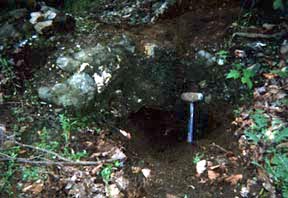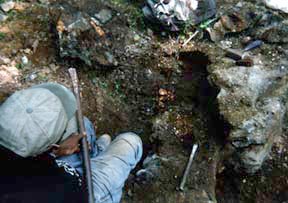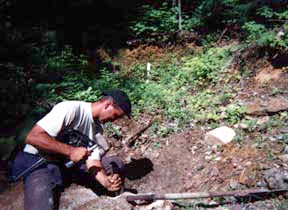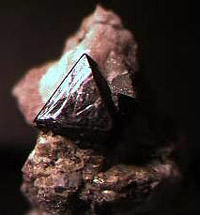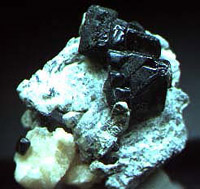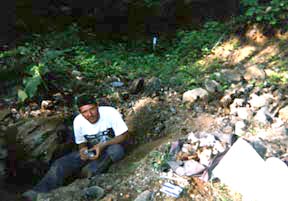 |
|||
|
|||
|
Copyright
Collecting Spinels at the Parker Mine, near Notre-Dame du Laus, Québec
During my summer vacation in July, 1999, I decided to go collecting at a locality other than Asbestos or Mont Saint-Hilaire (MSH). Besides, at Asbestos there is no access without the local club on certain dates, and MSH was not really exciting this year. So, my friend Raymond Féquière and I decided to look for an old mine in the woods to make it feel like a real expedition. We wanted to find some good material to show club members that there is always something good to be found everywhere. I contacted my good friend from the Club de Mineralogie de Montréal, Mr. André Bérard, who was a member since the club's founding. I could write an entire article about him to tell you why he is one of the "best of the best" collectors I know of. André visited the Parker Mine a long time ago and he explained to me the way to get there. The story is a bit like "after the big tree there is a big rock," etc. You know what I mean! But, he was really sure of how to get there – "when you are in the woods on that little mud track, after the second 'Y' in the road, take the right and it is in the wood, maybe 50 to 100 feet from the track, but it should be all covered with grass and trees by now." Hum!!! To find this spot would be a real challenge. The worst thing that could happen is to lose a day or two and put up with a lot of black flies. Those little bastards can eat you alive with your hammer in your hand! All my friends told me not to go, because "there is nothing left there". But they all said the same thing, "call me if you find something. I might go next week if you give me the directions to get there." Anyway, the club will be there with all the members two weeks after me. In the meantime, I would write down all the details for a quick access to the mine. If the mine is still good for collecting, it will be a good place for club members with kids too, because the danger is really limited to the walk in the woods – except maybe for the kids in the Blair Witch Project – but that's another story. The mine is located in one of the most beautiful parts of Quebec called Outaouais, with mountains, trees, rivers and lakes. This is the real country. It is just an hour north from the capital city Ottawa, or 2 hours from Montréal. What a treasure of beauty! Back on earth, we (Apollo 1) just missed the exit for Buckingham on highway 50 to get to Notre-Dame du Laus. Okay, I am back, and the mud track to the mine is only 10 minutes from the village along a river. All the indications from André Bérard were good, until now. The gate was open and the road looked passable for a car, but one had to keep an eye for the big rocks coming out of the ground. Excited by the proximity of the mine, I was just waiting for that second 'Y'. Alas, there it was. We packed our bags and we tried to find that little track to the mine about 50 to 100 feet away. We walked and walked again without success. It looked as though the track changed since my friend's last visit. I decided to go walk from the gate. Raymond followed in my car. I would be sure to see some residues left by some collector to show me the way. After 3 hours of walking, I finally found the track not after the second Y, but the 7th Y! Thank God for the guy who put a sign in the middle of the woods that said CLOSED MINE, because I would still have been walking in the woods by now. The picture on the left below shows the mud road access leading to the mine. Can you see the track? No? Me neither. The picture on the right shows the mine area with the red sign.
We used the sledgehammer, the hammer, the bars, the hands and even a couple of kicks to attack the bridge. There was a zone made of massive calcite with veins of massive olivine, so the chisel could get into the calcite without problem. The same thing applied for the bars and hammers; they just changed the calcite into powder. The "old fashion" way would work well. We then dug underneath until we could flip the bridge on its side and then break it apart using the hammer. Finally, we did it. And what a surprise! The calcite veins between massive olivine were filled with superb, shiny spinel and olivine crystals. The largest spinel crystal was more than one inch long! But all the crystals were in massive calcite. So, we carried everything to the car to bring home to dissolve the calcite and then expose the crystals. By removing the bridge, I was able to continue digging a little longer in my spot, and I checked the rotten area too for other specimens. We found very nice phlogopite mica crystals from a pocket in the floor. The day was almost over and the bugs were beginning to increase in number. We decided to call it a day and leave. The last photograph shows the dimensions of the hole we dug in the ground. It is large enough that I am able to lay down in it. What was once an apartment for a squirrel was now a great place for a bear to sleep in! We packed our belongings and left exhausted, but satisfied.
This article may not be copied, distributed or reprinted in any form without the author's permission. To contact the author, please use the e-mail address provided. If you are unable to contact the author, please contact the Canadian Rockhound. Authorized reprints must acknowledge the author, original source and the Canadian Rockhound. The preceding article is also available online at Daniel Comtois' website at www.simm.qc.ca/dancom/. All photographs are courtesy of Daniel Comtois. Additional photographs of the Parker Mine spinels and other minerals are availble online at www.multimania.com/dancom.
|
||||||

Copyright © 2000 Canadian Rockhound
Back Issues |
News & Events |
Junior Rockhound |
Resources
|
|||||||
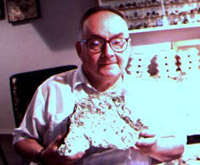
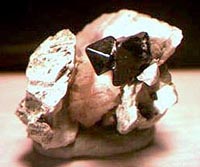
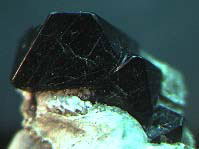
 Access to the Parker Mine. You can see the mud road on the left, but the track to the mine on the right is almost impossible to see.
Access to the Parker Mine. You can see the mud road on the left, but the track to the mine on the right is almost impossible to see.
